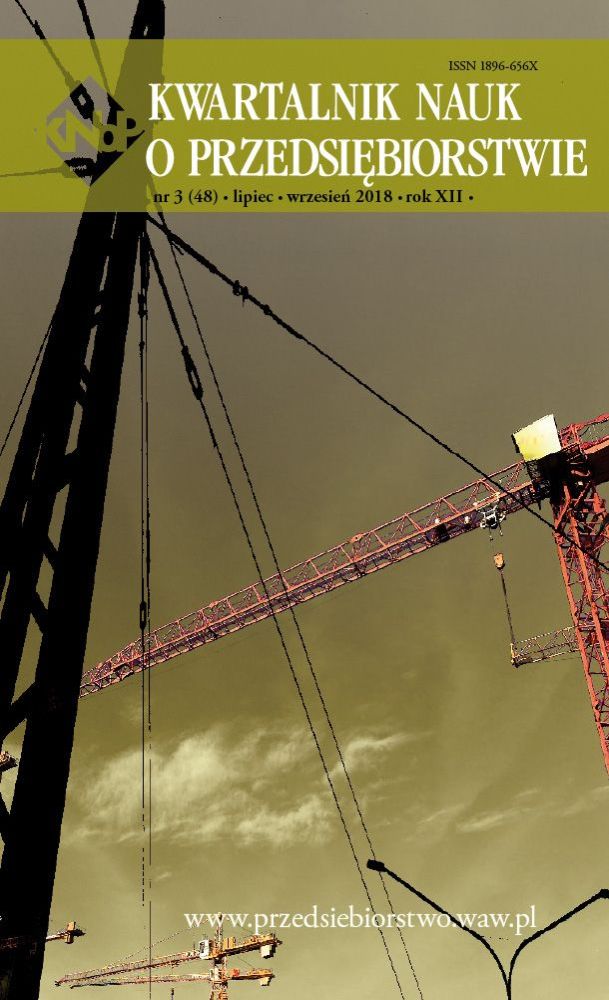Narzędzia do tworzenia właściwej percepcji CSR oraz rola PR
Main Article Content
Abstrakt
W artykule zostały omówione różnorodne metody mające na celu zwiększenie świadomości i zrozumienia społecznej odpowiedzialności biznesu wśród różnych grup akcjonariuszy. Celem badania jest wyodrębnienie narzędzi, które praktycy public relations (PR) powinni stosować w celu rozpowszechniania i promowania społecznej odpowiedzialności biznesu (CSR). Autor analizuje przydatność dwóch grup narzędzi: jakościowych oraz ilościowych. Wszystkie narzędzia zostały przeanalizowane pod kątem zakresu potrzebnych działań i zinterpretowane pod kątem przydatności do celów CSR.
Downloads
Article Details
Autor (Autorzy) artykułu oświadcza, że przesłane opracowanie nie narusza praw autorskich osób trzecich. Wyraża zgodę na poddanie artykułu procedurze recenzji oraz dokonanie zmian redakcyjnych. Przenosi nieodpłatnie na Oficynę Wydawniczą SGH autorskie prawa majątkowe do utworu na polach eksploatacji wymienionych w art. 50 Ustawy z dnia 4 lutego 1994 r. o prawie autorskim i prawach pokrewnych – pod warunkiem, że praca została zaakceptowana do publikacji i opublikowana.
Oficyna Wydawnicza SGH posiada autorskie prawa majątkowe do wszystkich treści czasopisma. Zamieszczenie tekstu artykuły w repozytorium, na stronie domowej autora lub na innej stronie jest dozwolone o ile nie wiąże się z pozyskiwaniem korzyści majątkowych, a tekst wyposażony będzie w informacje źródłowe (w tym również tytuł, rok, numer i adres internetowy czasopisma).
Osoby zainteresowane komercyjnym wykorzystaniem zawartości czasopisma proszone są o kontakt z Redakcją.
Bibliografia
Abercrombie N., Hill S., Turner B.S. [1994], Dictionary of sociology (3rd ed.), Harmondsworth, Penguin.
Artiola J.F., Pepper I.L., Brusseau M.L. [2004], Environmental Monitoring and Characterization, Elsevier Science & Technology Books.
Benn S., Todd L.R., Pendleton J. [2010], Public Relations Leadership in Corporate Social Responsibility, “Journal of Business Ethics”, Vol. 96(3). DOI 10.1007/s10551-010-0474-5.
Clark C.E. [2000], Differences between public relations and corporate social responsibility: An analysis, “Public Relations Review”, Vol. 26(3).
Federation of Small Businesses [2007], Social and Environmental Responsibility and the Small Business Owner, Federation of Small Businesses, London, December.
Grancea I. [2017], Social Engagement as a Vector of Brand Communication, “The Scientific Annals of Alexandru Ioan Cuza”, Vol. 10(1).
Garsten N., Bruce I. [2018], Communicating Causes: Strategic Public Relations in the Non-Profit Sector, Routledge.
Kim S-Y., Park H. [2011], Corporate Social Responsibility as an Organizational Attractiveness for Prospective Public Relations Practitioners, ”Journal of Business Ethics”, Vol. 103(4). DOI 10.1007/s10551-011-0886-x.
Kosterec M. [2016], Methods of Conceptual Analysis, “Filozofia”, Vol. 71(3).
Morgan D.L. [1996], Focus Groups, “Annual Review of Sociology”, Vol. 22.
Mundy D.E. [2015], Diversity 2.0: How the public relations function can take the lead in a new generation of diversity and inclusion (D&I) initiatives, “Research Journal of the Institute for Public Relations”, Vol. 2(2).
Muzykant V.L., Mfarrej F. [2018], Corporate Social Responsibility (CSR) of PR in Syrian and Russian telecommunication companies in crisis. A comparative analytical study on communication activities of MTN and MTC companies, “RUDN Journal of Studies in Literature and Journalism”, Vol. 23(1).
Okafor O.Ch., Nwatu Ch.B. [2018], Public relations as a tool for attaining educational institution objectives in ENUGU state, “International Journal of Marketing and Management Research”, Vol. 9(3).
Quinn D., Hargie O. [2004], Internal Communication Audits: A Case Study, “Corporate Communications: An International Journal”, Vol. 9.
Santos E.A. [2017], Prioritization of social actions developed by a company from Ponta Grossa – PR based on the social necessities of the region, Parana, Ponta Grossa, Federal University of Technology.
Social Audit [2005], Social Audit: A Toolkit A Guide for Performance Improvement and Outcome Measurement Director General & Executive Director, Centre for Good Governance, Jubilee Hills (India).
Ventresca M.J., Mohr J.W. [2001], Archival Research Methods, Joel A.C (ed.), Baum, Blackwell Publishers.
Verstappen S.H. [2001], Public & Corporate Relations Audit, San Francisco, Canto Public Relations Audit.

